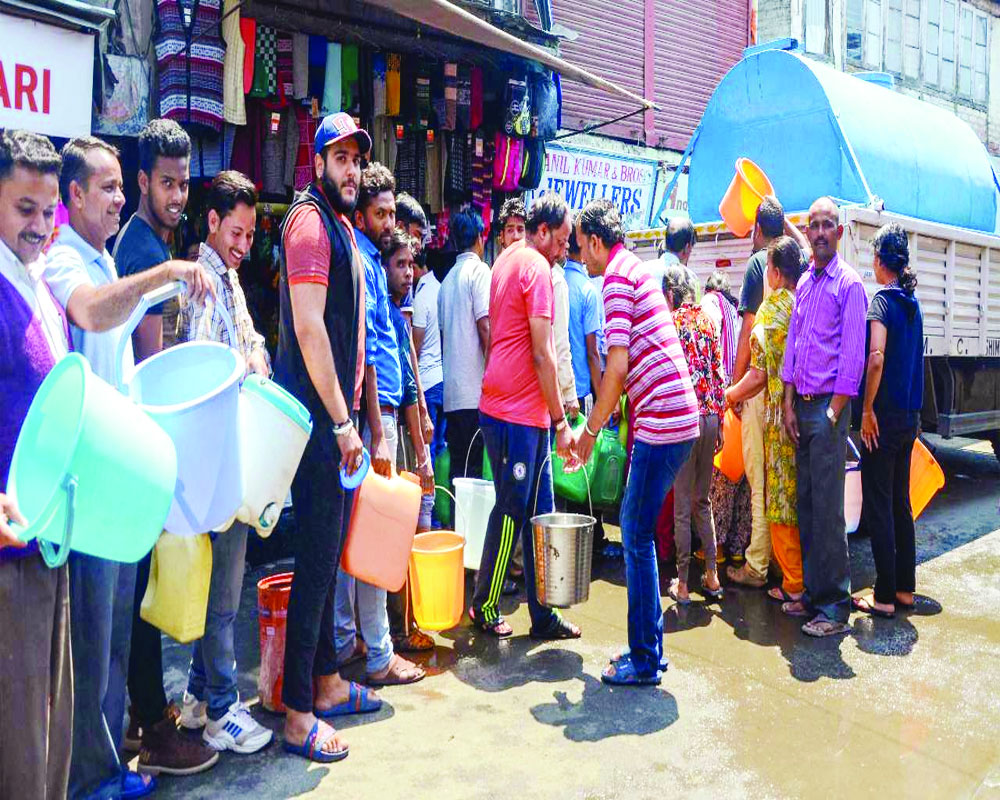The perennial water scarcity issue in Tamil Nadu can be resolved only if the politicians have the will to do so. But does it suit their interests?
Marudveidhe maanya jala pravahe
Kaverakanye namataam sharanye
Maanye vidhe mani suputri soumye
Kaaveri Kaaveri mama prasiida “
(Your copious flow swelled by cloud bearing Maruts Daughter of Kavera, I bow at your feet Divine mind-born daughter of the creator O Kaveri, shower your blessings on me)
This is from the hymn Kaveri Ashtakam sung in praise of river Kaveri, that reverberates from the banks along “Ganga of the South”, as Kaveri is addressed in Karnataka and Tamil Nadu. The 805-km-long river originates from Brahmagiri Hills (known as Thalakaveri) and meanders through Karnataka and Tamil Nadu before joining her husband Sagara Raja (Hind Mahasagar), irrigates and makes prosper the 72,000 sq km basin that falls in her path. The picturesque landscape along its route and the serene and peaceful atmosphere felt on both banks are visual splendours.
But not any more! The mention of Kaveri makes the Dravidian politicians see red. The river, flowing peacefully till 1967, has became a bone of contention between Karnataka and Tamil Nadu. Despite being an inter-state river, the political leadership of both States had displayed statesmanship and maturity in resolving the issues that had cropped up during drought years caused by deficient rainfall.
Old-timers like the late N Kalyanasundaram, the chronicler of Tamil Nadu’s political history, used to tell how K Kamaraj, the then chief minister of Tamil Nadu, rang up his Karnataka counterpart and requested for more water whenever the farmers complained to him of water shortage. The other side obliged and that too with a sense of pride. Gone are those good old days. MK Stalin and Siddaramaiah are brothers-in-arms fighting together to establish socialism, secularism and communal harmony across India. But they do not see eye to eye on the Kaveri issue.
Though there were issues between the States of Karnataka (then Mysore) and Tamil Nadu (previously Madras) long back, the agreements made in 1892 and 1924 to share the waters had resolved the dispute to a great extent. Over the years, the South Monsoon that feeds Kaveri’s catchment area became erratic due to the destruction of forests in Kerala, Karnataka and Tamil Nadu. The farmers of Tamil Nadu under the banner of Kaveri Delta Farmers Welfare Association had filed a writ petition in the Supreme Court seeking a directive to the Centre to refer the dispute relating to the utilization of Kaveri Water to the Inter-State Water Dispute Act, 1956. Subsequently, the Kaveri River Water Dispute Tribunal was set up for an amicable settlement.
The Tribunal’s award was that Karnataka should release 177.25 Thousand Million Cubic feet (TMC ft) of water to Tamil Nadu in a normal-water year (June–May). Of this, 123.14 TMC ft is to be released from June to September when farming operations are at their peak. But when rains fail, Tamil Nadu politicians get cold and start sneezing. The Tribunal has also fixed the quantity of water to be released by Karnataka every month.
Tamil Nadu claims that Kaveri is the lifeline of its five districts, which are known as the Delta Districts and the Rice Bowl. The Dravidian politicians blame Karnataka for its failure to release the monthly quota. Many times, the States have seen riots breaking out in Tamil Nadu against the people of Karnataka, and those in Karnataka return the compliment. Karnataka’s plan to build Mekadatu reservoir across the Kaveri to meet the drinking water requirements of Bangalore has met with strong resistance from the Dravidians because they fear that it is an attempt by Karnataka to rob Tamil Nadu of its due.
Tamil Nadu’s woe is that it does not have any major river and is fully dependent on Karnataka and Kerala (Mullaperiyar dam). However, the State has done nothing to resolve the issue with the help of modern technology. Surplus water from Kaveri is wasted into the Arabian Sea every year. All the engineers need to do is to divert a portion of the west-flowing surplus water to the Godavari/Krishna rivers through a network of canals. Tamil Nadu Government, which built the Chennai Metro through tunnels, can deploy boring machines to construct a series of tunnels to facilitate the flow of surplus water from Kaveri to Mettur dam.
“The UPA government will make a comprehensive assessment of the feasibility of linking the nation’s rivers . The UPA will take all steps to ensure that long-pending inter-state disputes on rivers and water-sharing like the Cauvery waters dispute are settled amicably at the earliest,” said its Common Minimum Programme before it came to power in 2004. Now, there is no CMP or UPA!
Tamil Nadu should have built a series of desalination plants along its 1076-km coastline. Though there are two Central institutions in Chennai (Indira Gandhi Centre for Atomic Research, and National Institute of Ocean Technology) with expertise in setting up desalination plants, no one from the State has made any attempt to bring these organizations into the loop. For politicians in Tamil Nadu, water should remain a burning issue for their survival. May God save the Dravidians and Tamil Nadu!
(The writer is a Special Correspondent with The Pioneer. The views expressed are personal)
























